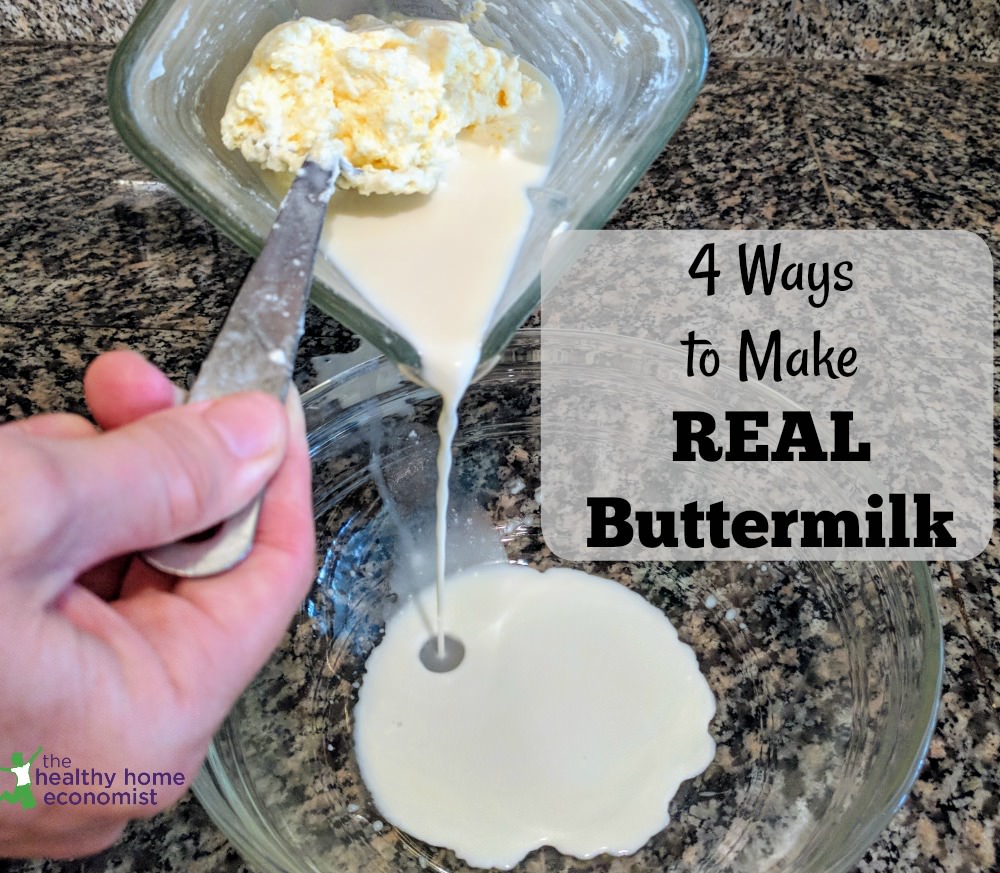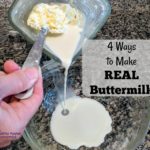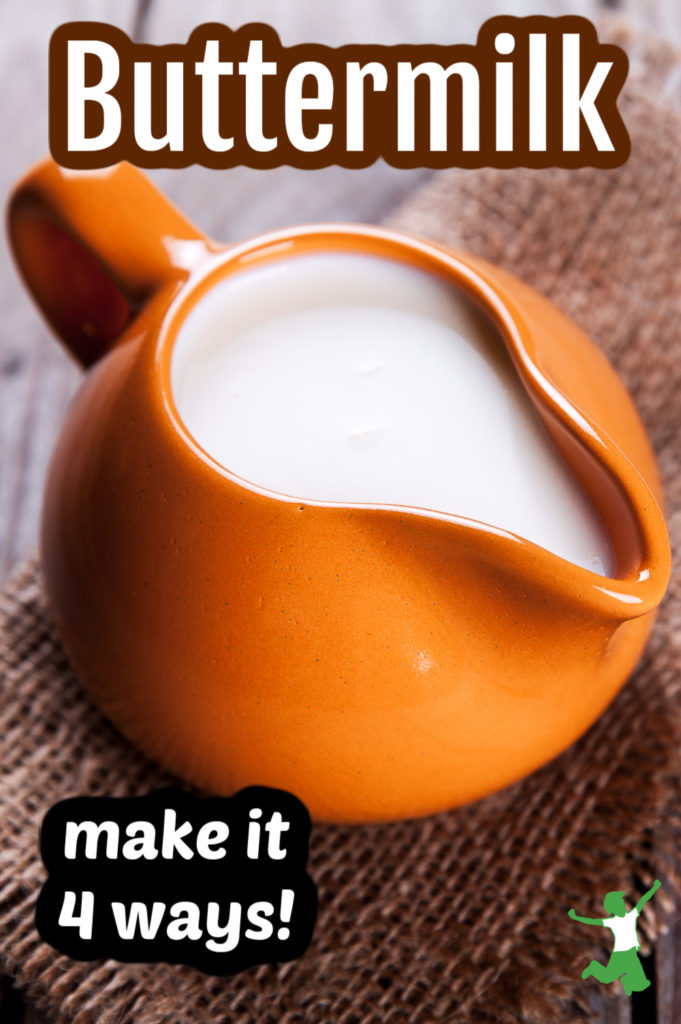Table of Contents[Hide][Show]
Four easy methods for making real buttermilk that is loaded with probiotics and enzymes to facilitate digestion with delicious, old fashioned taste.

My recent recipe for homemade quark resulted in a number of emails asking about how to make cultured buttermilk, a key ingredient in this German-style soft cheese.
I decided to devote an entire article to my response because, in my view, buttermilk is quite possibly the most confusing of all cultured dairy foods!
Traditional Cultured Buttermilk
In its true form, traditional buttermilk is a thin, milky, beige or even grayish colored liquid that is the by-product of churning slightly soured, probiotic-rich cream into butter. It is rich in beneficial lactic acid bacteria and enzymes, which is why people frequently enjoyed it as an effective natural remedy for indigestion. It also contains very low levels of lactose, and for this reason, is usually tolerated well by the lactose intolerant.
Most people have never seen this kind of real buttermilk, however! They are familiar primarily with the buttermilk from the supermarket made of pasteurized milk thickened with buttermilk powder and potentially other additives as well.
This factory produced buttermilk contains no probiotics or enzymes whatsoever. It also contains a lot of lactose. It might taste like buttermilk, but it isn’t really buttermilk at all.
Grassfed Buttermilk?
Even the grass-fed buttermilk you might find in some health food stores isn’t the real thing. One brand carried by Whole Foods lists these ingredients:
Organic Fat Free Milk, Organic Tapioca Starch, Organic Guar and Locust Bean Gum, Sea Salt, Cultures.
It’s nice that the ingredients are all organic, the pasteurized milk comes from grass-fed cows, and the product contains some probiotic cultures, but this isn’t real buttermilk!
The Many Ways to Make Homemade Cultured Buttermilk
Another reason buttermilk is so confusing is that there are a number of ways to make it.
Below is an overview of four different traditional methods. The last one is my favorite because it costs nothing and takes no extra time. The recipe at the end covers methods 1 and 2.
How to Make Buttermilk from Cream
- Unpasteurized cream that is slightly soured is naturally rich in enzymes and probiotics. Churning this type of cream (I use a blender or a hand mixer to make it very easy) produces raw butter along with small amounts of cultured buttermilk. You can see what the process looks like in this video recipe on how to make butter. The picture above shows me pouring the buttermilk into a bowl after churning the cream into butter with my blender.
- Buttermilk is best made with raw cream. However, if all you have is pasteurized cream, you can still make it (do not use ultra-pasteurized or UHT cream). This type of cream is void of any probiotics or enzymes due to high heat processing. Hence, uncultured butter and buttermilk are the results when you churn it. However, you can then add buttermilk starter culture and ferment this uncultured buttermilk into cultured buttermilk.
- Yet a third way to make cultured buttermilk is to make homemade cultured cream before churning it into cultured butter and buttermilk.
The Easiest Method
A final way to make homemade buttermilk is to simply buy a quart from a local raw dairy farm. It is usually quite inexpensive too since it is the by-product of making butter. Leave this raw, uncultured buttermilk on the counter for 1-2 days before refrigerating. This will allow it to naturally sour into cultured form.
Now you know that true buttermilk is the thin liquid leftover from churning cream into butter. It is not whole, low-fat, or nonfat milk with buttermilk powder and thickeners added. Neither is it milk cultured with buttermilk starter.
You can certainly make it this way if you like. In fact, most recipes on the internet suggest this method. However, it is not the real thing. In that case, the thickened buttermilk is more like a drinkable style yogurt or kefir.
Benefits of Real Cultured Buttermilk
After reading all of the above, you might wonder why bother making real buttermilk? Why not just ferment milk with buttermilk starter and be done with it? Is this modern method so bad after all? Why take the extra step of making real butter just to obtain the liquid that is leftover?
The reason is that one of the huge benefits of real buttermilk is that it contains little to no lactose. For this reason, traditional buttermilk is an excellent fermented beverage for lactose intolerant people to obtain dairy calcium without adverse effects. (1)
Using commercial buttermilk from the store or making it out of milk instead of cream results in a lactose-rich, high carb buttermilk.
Real Buttermilk is Low Carb, Fake Buttermilk is High Carb
Besides being very low in lactose, real cultured buttermilk is also low carb. This compares to high carb commercial buttermilk made from milk.
For example, one pint of heavy grass-fed cream churned into butter yields approximately a half pound of butter plus 1 cup of buttermilk. This buttermilk is very low in carbohydrates with one serving containing <1 carb. (2)
Contrast this with one cup of whole milk with added buttermilk powder and thickeners. This buttermilk is high in carbohydrates, containing roughly 12 grams per cup! (3)
Thus, real buttermilk is more keto diet friendly than modern buttermilk.
How to Use
It is important to note that buttermilk should be cultured in order for it to be acidic enough (from the beneficial lactic acid bacteria) to be used for soaking flour for pancakes, soaked waffles, soaked bread and so forth.
As mentioned earlier, cultured buttermilk is also an important ingredient for making homemade quark, a German-style dairy food similar in texture to Greek yogurt.
Buttermilk also should be cultured when used as a natural remedy for indigestion or sour stomach.

Homemade Traditional Buttermilk (Low Carb, Probiotic Rich)
Easy blender method for making buttermilk out of heavy whipping cream. One pint of cream produces a half pound of butter and one cup of plain or cultured buttermilk.
Ingredients
- 1 pint heavy whipping cream preferably raw and grass-fed
- 1 buttermilk starter not needed if using raw cream
Equipment
- 1 blender or food processor
Instructions
-
Pour cream into the blender or food processor. Secure the lid firmly.
-
Turn on low and let the cream churn for 5-10 minutes. If your cream is very fresh and cold, it will take longer to whip into butter.
-
Once you can see the separation of butter from buttermilk is complete, turn off the blender and carefully pour the buttermilk into a bowl. If you use a fine mesh cheesecloth, you will separate out all the small bits of butter as well.
-
If you want cultured buttermilk and you used raw cream, leave the strained buttermilk on the counter in a sealed mason jar for 1-2 days. It will naturally ferment into cultured buttermilk.
-
If you used pasteurized cream, add buttermilk starter and use as directed.
-
You will end up with about 1 cup of butter and 1 cup of buttermilk.
Recipe Notes
Do not use UHT ultrapasteurized cream even if organic. It is denatured for excessively high heat processing and sometimes even contains unnatural thickeners.
This article on UHT milk explains more.









Thanks so much for responding! I’ll have to do more searching to find information about whether the calcium in things like yogurt and clabbered milk really blocks the breakdown of phytic acid…. I’ve been reading and studying so much that I’m not sure where I read that… May have just been in the comments somewhere.
And all this time I just thought buttermilk was basically soured or clabbered milk. I finally found a source of raw milk in my very small community and didn’t have my fridge set low enough and three-quarters of it went sour. So I used it in buttermilk waffle recipes and let it sit out in the garage for probably 12 hours and then brought it in and put it in the fridge for the next morning. I’m in Arizona so it’s hot and the batter took on a very sour smell (not spoiled just sour} but it made excellent waffles. I’ve been using this clabbered raw milk in place of buttermilk. It works really well even if it isn’t real buttermilk.
Now I’m concerned because I’ve seen data showing that using yogurt, buttermilk, Etc for soaking flour is not very effective at breaking down phytates due to the calcium content. Is that correct? And also is whey high in calcium or is it just the full milk products that have the calcium? Finally, does the carb content of clabbered milk decrease the longer it’s left to sour (up to a point) ? Meaning do the live bacteria in the milk consume the sugars in it and lower the carb content over time?
Yes, the probiotics use the lactose (milk sugar) and the carbs decrease as the dairy ferments. Yogurt, kefir and other forms of fermented dairy cultured for 24 hours or more are virtually lactose free.
thanks for sharing your work Sarah. I tried making kefir once and it was a disaster LOL. Tho I would love to try making my homemade buttercream I am a little scared it would turn up a mess again 🙂
Always use two tablespoons of vinegar with one cup of regular milk to make real buttermilk and it becomes nice and thick if you put it in the microwave for at least 1 minute
Unfortunately, the method you are describing is not going to produce enzyme and probiotic rich buttermilk. What you are using is a more conventional method — not the traditional method which produces nutrient rich, digestible buttermilk. I suggest you try one of the methods above for a much healthier buttermilk.
Good recipe thank you very much
So I’m guessing the old trick of using 1 Tbsp of vinegar or lemon juice in one cup of milk and waiting 10 minutes to sour the milk into “buttermilk” does not work with raw milk?? I’ve waited 30 minutes after trying it (and before reading your article) and the raw milk has not thickened and just tastes like lemon flavored milk.
That sounds like a “trick” that has been used with pasteurized milk.
I can hardley wait to. make butter & buttermilk the way my Grandma did , when i was young ! I miss her advice, compassionate nature and her butter & butfermilk. Thank you for the info.
In step 4. you mentioned culturing in a sealed mason jar. That goes against everything I was ever taught by the family-cow-farming-folk I grew up with.
I’ve been making butter and culturing raw milk products for many years. Culturing in a tightly sealed jar doesn’t allow gasses to escape – it results in a non-appetizing separated product. Cover the jar with a clean towel or at least leave the lid cracked to get a lovely thickened-pleasantly-soured finished product.
For the person using Raw milk or Cream start with fresh. Old milk or cream separates and has an unpleasant bitter flavor.
Our grandmothers didn’t have refrigerators. Their fresh cream (stored in the spring-house in a loosely covered crock) turned sour very quickly so they were forced to make butter often. We now can keep our tightly covered raw cream fresh for a week or two in the fridge which is a very different product. Once “refrigerated cream” starts to sour it is too far gone for culturing. It’s fit for use in baked goods only.
Another note:
Cultured products get best if set to culture near a heat source. In the summer (no air conditioning) the counter is fine. In the winter behind the wood stove or in the oven with the light on gives me the best results.
Interesting! Thanks for the information. I’ve always cultured in a sealed mason jar (filled no more than an inch from the top for escaping gasses as you said) and never had a problem. I do the same when making kefir or yogurt. We have cats that would stick their noses into the jars if they were only covered by a towel! LOL That said, the fermentation process only takes about 24 hours so it doesn’t cause enough gas pressure build-up to be a problem in my experience, and I’ve fermented dairy for almost 20 years.
I buy grass fed heavy cream from a local farm to churn into butter. For cultured butter, I add a scoop of yogurt to the cream, let it cultured then churn. The buttermilk is really tangy and delicious and is a drinkable consistency. When I make sweet cream butter, I just add yogurt to the sweet buttermilk and let it culture. This turns out more like scoop-able yogurt. Technically not legit buttermilk without the buttermilk culture, but both work well in recipes and are yummy plain too. My favorite use for it is fluffy pancakes!
Well, shoot. I thought I had some buttermilk in my refrigerator. I guess not. What does raw milk that’s gone “bad” turn into? If it hadn’t gone bad?
What you have is clabbered milk, not buttermilk. Here’s more information about it. https://www.thehealthyhomeeconomist.com/help-my-raw-milk-wont-clabber/
Now I know why I can drink the buttermilk my farmer bottles after making butter, but when I buy the organic buttermilk at the store, I get terrible bloating. The real buttermilk from the farm has no lactose! I assumed the stuff from the store was fermented and also had no lactose, but boy was I wrong about that ):